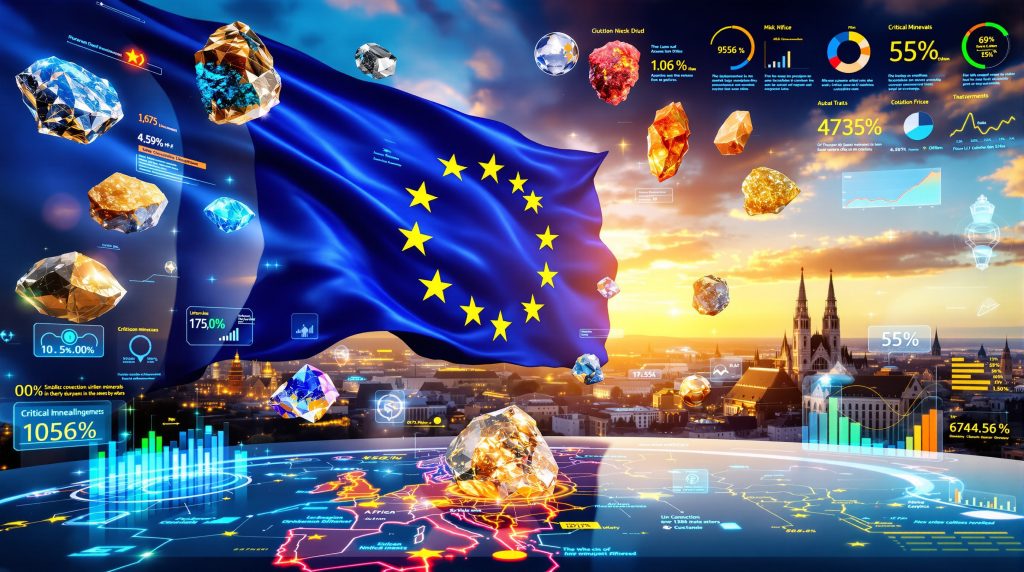The global minerals landscape is experiencing unprecedented transformation as governments worldwide reassess their strategic resource policies. This shift reflects deeper changes in how advanced economies view critical material access within their broader national security frameworks, with EU minerals policy and US interventionism emerging as key models for state-led resource security strategies.
Traditional market-driven approaches to mineral procurement are giving way to more direct state intervention, driven by supply security concerns and geopolitical tensions. These developments have prompted policymakers to reconsider the balance between market efficiency and supply security, leading to increasingly interventionist approaches across major economies.
Understanding Europe's Critical Materials Transformation
European policymakers are confronting a complex web of supply dependencies that threaten key industrial sectors and strategic objectives. The continent's renewable energy transition relies heavily on materials with highly concentrated production, creating vulnerabilities that extend far beyond simple market volatility. Furthermore, the EU minerals directive provides the regulatory framework for addressing these strategic challenges.
Wind Energy Supply Dependencies:
- Permanent magnet requirements for wind turbines depend on rare earth elements
- China controls approximately 70% of global rare earth element processing capacity
- Manufacturing concentration creates bottlenecks in turbine production
- Limited alternative sourcing options increase price volatility risks
Electric Vehicle Battery Constraints:
The automotive sector's electrification faces material availability challenges across multiple battery chemistries:
- Lithium supply growth struggles to match projected demand increases
- Cobalt sourcing concentrated in politically unstable regions
- Nickel grade requirements limit suitable mining operations
- Processing capacity remains geographically concentrated
Defense Industry Exposures:
Military applications require specialty metals with unique properties and limited substitution possibilities. These materials often come from producers with complex geopolitical relationships, creating supply security challenges that extend beyond commercial considerations.
Industrial Manufacturing Vulnerabilities:
Advanced manufacturing sectors, particularly semiconductors and precision electronics, depend on minor metals with concentrated production bases. Supply disruptions in these materials can cascade through entire industrial ecosystems, highlighting the importance of understanding rare earth dependencies.
Catalysts Behind European Policy Evolution
The period from 2022 through 2024 marked a turning point in European resource security thinking, as multiple simultaneous crises exposed the limitations of purely market-based approaches to critical material procurement.
Supply Chain Disruption Lessons
Recent global events demonstrated how quickly mineral supply chains can fragment, forcing European officials to reassess fundamental assumptions about resource availability and market stability. These disruptions revealed that traditional hedging mechanisms and inventory management practices were insufficient for truly strategic materials.
European Commission deputy director-general of trade Denis Redonnet acknowledged that measures including price floors, mandatory sourcing requirements, and long-term offtake agreements are under active consideration. The official noted that "while these approaches require careful consideration due to their market intervention implications, they represent necessary tools for ensuring supply security."
Quantified Risk Assessment
Cobalt Market Volatility:
The Democratic Republic of Congo's temporary export restrictions demonstrated the scale of supply concentration risks. DRC producers account for 76% of global cobalt feedstock supply, and the export ban led to a 2.5-fold increase in cobalt hydroxide prices between February and September 2024. This volatility exemplifies the broader cobalt market dynamics affecting European industry.
Battery Import Dependencies:
China exported 1.05 million tonnes of lithium-ion batteries to Europe in 2024, representing 35% of China's total battery exports. This dependency extends beyond final products to encompass critical processing stages and raw material preparation.
Urgency in Strategic Planning
Alberic Mongrenier, executive director of the European Initiative for Energy Security, emphasised that truly strategic projects require rapid financing mechanisms. His recommendations include repurposing existing public funds and initiating offtake negotiations with metals producers to mirror successful American approaches.
European Interventionist Strategy Implementation
Brussels is developing comprehensive policy frameworks that blend government oversight with private sector efficiency, drawing lessons from American precedents whilst maintaining distinctly European characteristics. However, the approach differs significantly from American models, as shown in our detailed US-EU policy comparison.
Financial De-risking Architecture
The EU Resource Plan represents a cornerstone initiative for identifying alternative sources for critical minerals. Denis Redonnet indicated that this proposal was being finalised for European Commission approval in December 2025, providing a framework for systematic supply diversification.
Long-term Offtake Agreements:
American precedents include secured deals with companies such as Critical Metals and Ucore Rare Metals for rare earths from Greenland and Canada. European policymakers are exploring similar arrangements to provide market certainty for strategic projects.
Equity Participation Models:
The EU is considering taking equity stakes in companies, following the American model of direct government investment in strategic mineral ventures. This approach would provide both financial support and policy oversight for critical projects.
Mandatory Compliance Frameworks
Strategic Project Sourcing Requirements:
European officials are developing mandates requiring companies to source materials from designated strategic projects for both upstream and midstream operations. These requirements would apply particularly to defence contractors but could extend to automotive and other critical sectors.
Battery Passport Regulation:
Beginning February 18, 2027, the EU will require electric vehicle and industrial batteries exceeding 2kWh capacity to carry electronic registration through battery passports. This system, detailed in the battery passport regulation, includes:
- Identification QR codes and CE marking requirements
- Full lifecycle transparency documentation
- Supply chain traceability management
- Carbon footprint certification compliance
Major Chinese battery producer Sunwoda established a dedicated project team in November 2023 to ensure European market compliance with the new regulations, highlighting the global impact of European policy decisions.
Scrap Material Control Measures
Aluminium Scrap Export Restrictions:
European Commission trade and economic security commissioner Maros Sefcovic announced preparatory work on measures to ensure adequate aluminium scrap access for European recycling industries. The EU and UK together exported approximately 1.6 million tonnes of aluminium scrap in 2024, representing a 25% increase from 2022 levels.
The measure, likely to be adopted in spring 2026, could include export tariffs or quotas to prevent what European Aluminium director-general Paul Voss characterised as "market failure" in scrap material flows.
Comparative Analysis: European vs American Interventionism
American critical minerals policies have established precedents that inform European strategy development, though each approach reflects distinct regional priorities and governance structures. Moreover, EU minerals policy and US interventionism showcase different philosophical approaches to state involvement in strategic resources.
US Strategic Acquisition Methods
American interventionist strategies encompass multiple coordinated approaches:
- Defense Production Act funding for domestic mineral processing
- Price floor mechanisms to reduce investment uncertainty
- Direct equity acquisitions in foreign mineral companies
- Long-term supply agreements with North American producers
The United States has secured strategic partnerships extending beyond North America, with agreements covering rare earth supplies from Greenland and Canada providing long-term supply certainty.
European Adaptation Strategies
Environmental Integration Requirements:
European frameworks mandate comprehensive environmental standards throughout mineral project lifecycles. The battery passport regulation requires carbon footprint documentation, with leading automotive customers setting maximum emissions targets of 25kg CO2 per kWh for battery production.
Multilateral Coordination Emphasis:
European approaches prioritise international partnerships and shared governance structures, contrasting with more unilateral American implementations. This reflects Europe's diplomatic tradition and complex multi-member governance requirements.
Technical Compliance Complexity:
Chinese battery companies face systematic challenges meeting European requirements, including supply chain traceability management, compliance due diligence, recycled material utilisation improvements, and carbon footprint certification implementation.
Core Components of European Resource Planning
Critical Raw Materials Act Framework
The Critical Raw Materials Act establishes comprehensive oversight mechanisms for strategic mineral management, though specific implementation details continue evolving through regulatory development processes. Additionally, mining companies face new regulatory compliance requirements under this framework.
Supply Chain Monitoring Systems:
Real-time tracking capabilities for critical material flows, supported by digital infrastructure requirements including the battery passport system and associated documentation protocols.
Strategic Project Designation:
Fast-track approval processes for critical mineral developments, providing regulatory certainty and accelerated permitting for qualifying projects meeting strategic criteria.
Regional Development Coordination
European mineral policy encompasses both domestic resource development and international partnership frameworks designed to diversify supply sources and reduce concentration risks.
Nordic Integration Projects:
Finland, Sweden, and Norway represent key focus areas for battery material processing and critical mineral extraction, despite Norway's non-EU status requiring bilateral cooperation frameworks.
Central European Capabilities:
Czech Republic, Poland, and Slovakia offer strategic locations for automotive supply chain integration and battery recycling infrastructure development, leveraging existing industrial capabilities and geographic advantages.
International Partnership Development
Diversification Partnerships:
Strategic alliances with Australia, Canada, and emerging producers provide alternatives to concentrated supply sources whilst maintaining compatibility with European environmental and social standards.
Technology Transfer Facilitation:
Public funding mechanisms support research and development in critical mineral processing technologies, enabling European companies to develop domestic processing capabilities even when raw material extraction occurs internationally.
Implementation Challenges and Constraints
Market Efficiency Concerns
Critics argue that interventionist policies may create unintended consequences that undermine long-term competitiveness and innovation incentives. In fact, policy experts suggest careful coordination is essential to avoid market distortions.
Price Discovery Disruption:
Government intervention in mineral markets can distort natural price mechanisms, as demonstrated by the cobalt market's extreme volatility following DRC export restrictions. This suggests that intervention, whilst sometimes necessary for security reasons, can create rather than eliminate price instability.
Innovation Impediments:
Regulatory requirements and mandatory sourcing provisions may slow technological advancement by creating compliance burdens that divert resources from research and development activities.
Environmental and Social Complexity
Lifecycle Assessment Requirements:
All strategic projects must demonstrate comprehensive environmental compatibility, potentially extending development timelines. The battery passport regulation requires detailed carbon footprint documentation, with upstream supply chain processes accounting for up to 80% of total emissions.
Community Engagement Standards:
European frameworks emphasise stakeholder consultation processes that may delay project implementation but are considered essential for maintaining social licence to operate in European contexts.
Climate Compatibility Integration:
Mineral projects must align with EU carbon neutrality objectives, creating additional technical and financial requirements for project developers.
What Are the Main Governance Coordination Difficulties?
Multi-level Implementation:
European Union governance structures require coordination between Commission-level policy development and member state implementation, creating potential delays and inconsistencies in programme execution.
Competitive Project Allocation:
Competition between member states for strategic project designations and funding allocations may create political tensions and suboptimal resource allocation outcomes.
Regulatory Harmonisation Needs:
Differing national standards across EU member states require extensive coordination efforts to ensure consistent implementation of strategic mineral policies.
Future Evolution Through 2030
Technology Integration Scenarios
European interventionist strategies will likely incorporate digital infrastructure and advanced monitoring capabilities to improve supply chain visibility and risk management. Consequently, EU minerals policy and US interventionism will increasingly rely on technological solutions.
Battery Passport Digital Infrastructure:
The February 2027 implementation of mandatory electronic registration for large batteries represents a concrete example of technology integration in regulatory frameworks. This system will provide unprecedented visibility into battery supply chains and lifecycle performance.
Low-Emission Processing Technology:
Calix's Zero Emissions Steel Technology demonstrates emerging approaches to mineral processing that align with European climate objectives. The technology uses 54kg of hydrogen to produce one tonne of iron, with Rio Tinto investing A$35 million to support demonstration plant development planned for 2028.
Regulatory Framework Expansion
Strategic Reserve Management:
Automated systems for maintaining optimal stockpile levels may incorporate artificial intelligence for demand forecasting and supply risk assessment, though specific implementation details remain under development.
Emergency Response Protocols:
Rapid deployment mechanisms for supply chain disruptions will likely draw lessons from recent crisis responses, incorporating both market-based and administrative tools for crisis management.
How Will Investment Strategy Evolve?
Green Development Banking:
Specialised financial institutions focused on sustainable mineral development may emerge to address the unique financing needs of projects meeting both strategic and environmental criteria.
Risk Insurance Mechanisms:
Government-backed insurance products for strategic mineral investments could reduce private sector risk exposure whilst maintaining market-based allocation mechanisms for project selection and management.
Global Market Transformation Implications
Competitive Response Dynamics
European interventionist policies are influencing strategic calculations across major global economies, creating feedback loops that reshape international mineral markets.
Chinese Strategic Adjustments:
Beijing is reassessing export policies and domestic stockpiling strategies in response to European supply diversification efforts. Chinese battery producers are investing heavily in compliance systems to maintain European market access under new regulatory requirements.
Emerging Producer Positioning:
Countries including Chile, Argentina, and the Democratic Republic of Congo are adapting their mineral policies to attract European investment and partnerships. Argentina's consideration of glacier protection law revisions, for example, reflects efforts to unlock copper resources that could serve European supply diversification objectives.
Market Structure Evolution
Supply Chain Regionalisation:
Movement toward regional security blocs is replacing globally integrated supply chains in critical minerals. This transformation prioritises supply security over pure cost optimisation, fundamentally altering traditional trade patterns.
Investment Pattern Shifts:
Capital flows increasingly favour projects in politically stable jurisdictions with strong environmental compliance capabilities, even when production costs exceed alternatives in less stable regions.
Price Formation Changes:
Government intervention and strategic stockpiling may reduce extreme price volatility whilst potentially raising average price levels for critical minerals, as market forces incorporate strategic premium values into pricing mechanisms.
Strategic Balance Assessment
European critical minerals policy represents a fundamental shift from market-reliance toward strategic autonomy, prioritising supply security alongside traditional economic efficiency considerations. This transformation reflects broader changes in how advanced economies approach resource security within increasingly fragmented global systems.
Success will require balancing multiple competing objectives: maintaining private sector innovation incentives whilst providing government security guarantees, achieving environmental leadership whilst ensuring industrial competitiveness, and securing European strategic interests whilst preserving international cooperation opportunities.
The ultimate measure of European interventionist success will be whether these policies deliver both strategic resilience and economic prosperity whilst maintaining Europe's commitment to environmental sustainability and social responsibility. As implementation continues through 2030, European approaches may serve as templates for other developed economies seeking to navigate similar tensions between market efficiency and supply security.
Furthermore, the evolution of EU minerals policy and US interventionism will continue shaping global resource strategies as other nations develop their own approaches to critical materials security in an increasingly complex geopolitical environment.
Disclaimer: This analysis involves forecasts and projections about future policy developments and market conditions. Actual outcomes may differ materially from these assessments due to changing political priorities, technological developments, and unforeseen market dynamics.
Are You Positioning for the Next Major Mineral Discovery?
Discovery Alert's proprietary Discovery IQ model delivers instant notifications on significant ASX mineral discoveries, empowering subscribers to identify actionable opportunities ahead of the broader market in this rapidly evolving minerals landscape. Understand why historic discoveries can generate substantial returns by exploring Discovery Alert's dedicated discoveries page, and begin your 30-day free trial today to secure your market-leading advantage.



